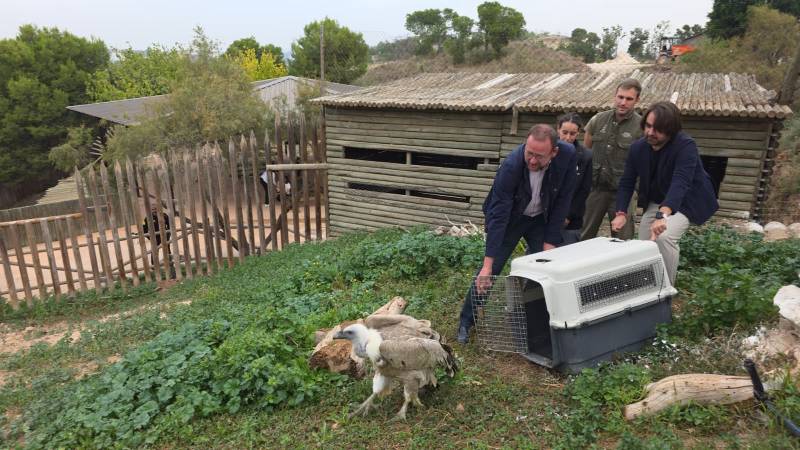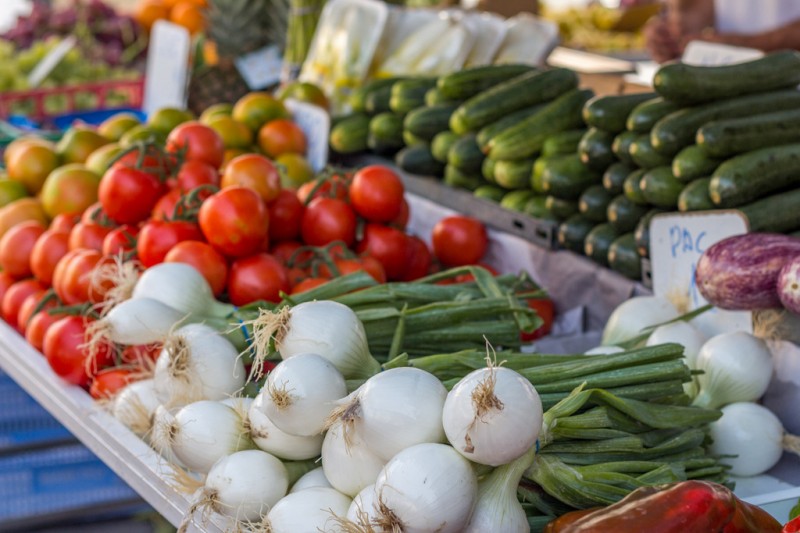
To be listed on the haciendadelalamo TODAY MAP please call +34 968 018 268.
Murcia Cathedral
Iglesia Catedral de Santa María en Murcia
Murcia Cathedral
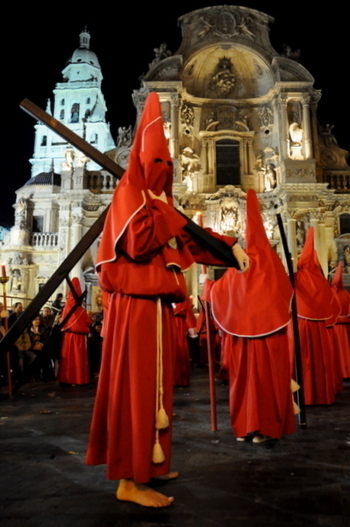
It´s a riot of exquisite detail, both inside and out, with elements of Gothic, Renaissance and Baroque architecture, each part with its own unique personality. The magnificent Torre-campanario, the bell tower is 90 metres tall, housing 24 bells, dating from the 17th and 18th centuries, each named individually: La Fuensanta, La Concepción, La Catalana.... the bells serving to not only call Murcians to prayer, but also ring out warnings of wars, of floods, as well as in happier times, ringing out messages of peace and celebration.
The true glory of this Cathedral , however, is not just the proliferation of exuberant detail which can embrace the observant visitor who wishes to look for it, but the fact that this cathedral is so much a living 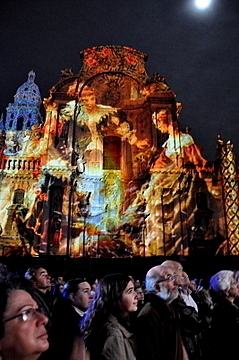
It really is a living part of the soul of the City of Murcia.
The Cathedral itself has 3 separate naves and a total of 23 chapels, including the imposing and distinctive Chapel of Los Vélez, a monument to one of the most powerful and important families in the history of the Region of Murcia.
Have a good look at the Capilla de Junterones, which is a Renaissance work, as well as the Capilla de la Inmaculada which is an impressive Baroque work.
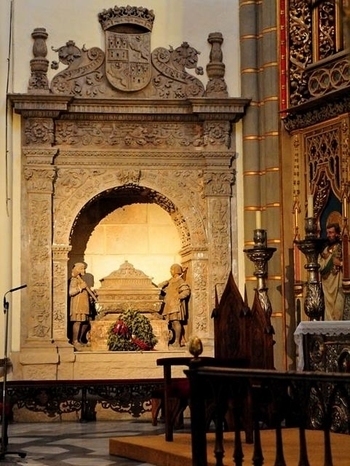 Another very important feature is the stone coffer in the Alter Mayor, which contains the heart and entrails of Alfonso X, known as El Sabio, the Wise one, a King who played such a vital ròle in the development of Spain and created important legislation which is still relevant today.
Another very important feature is the stone coffer in the Alter Mayor, which contains the heart and entrails of Alfonso X, known as El Sabio, the Wise one, a King who played such a vital ròle in the development of Spain and created important legislation which is still relevant today.
As a young prince he conquered Murcia, redefining its identity, changing a Muslim City to a Catholic City, his wish when he died that his heart be left to the City which he loved so much. It´s a poignant reminder of this important King, a reminder of his presence here in Murcia, a presence which is also reflected in other cities such as Lorca and Caravaca de la Cruz.
Having visited the inside, take a walk around the outside, as there is an impressive sculptured chain around the chapel of Los Vélez , and characterful streets and plazas leading off around the cathedral, which hide some of the most interesting and attractive corners of the capital.
Murcia Cathedral opening hours
 There are two options within the Cathedral, either a visit to the main Cathedral which is free, or to include a visit to the Cathedral Murcia, which is a paid option.
There are two options within the Cathedral, either a visit to the main Cathedral which is free, or to include a visit to the Cathedral Murcia, which is a paid option.
The main Cathedral is open from 7am to 1pm and then from 5pm to 8.30pm
Entry is free.
Visiting the Cathedral Museum and Tower
( see detail at bottom of page.)
History of Murcia Cathedral.
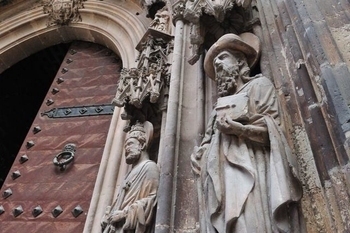 Murcia was occupied by the Moors until the first Reconquista of Murcia by Alfonso X as a young Prince in 1243, and most of the current cathedral lies on top of what used to be the prayer area of the old main mosque. Part of the original Mosque can be seen in the Cathedral Museum.
Murcia was occupied by the Moors until the first Reconquista of Murcia by Alfonso X as a young Prince in 1243, and most of the current cathedral lies on top of what used to be the prayer area of the old main mosque. Part of the original Mosque can be seen in the Cathedral Museum.
The Cathedral is the only Cathedral within the Region of Murcia, falling within the Diocese of Cartagena, which was re-established in 1243. In 1291 the Episcopal seat was officially transferred from Cartagena to Murcia by the royal decree of King Sancho IV.
Following uprisings of the remaining Muslim population in 1266, the Christians retook the city for the second time, and the main mosque in Murcia was converted into a Christian seat of worship, and renamed Santa María de Murcia.
It´s a common occurrence, this recycling of existing buildings for a new religion and a new purpose, and throughout the region of Murcia you´ll find Christian churches built on Roman Temples and Muslim Mosques, a reflection of the many races and religions which have occupied these territories.
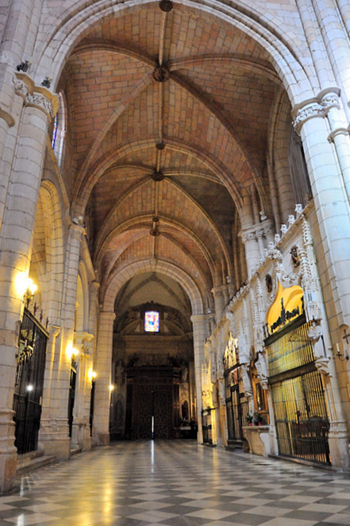 Around it constructions of chapels and annexes began to form, the first record dating back to 1295, when a chapel was built, dedicated to Saint Simon and Saint Judas and housing the coffin of the Murcian lawyer Jacobo de las Leyes and his family.
Around it constructions of chapels and annexes began to form, the first record dating back to 1295, when a chapel was built, dedicated to Saint Simon and Saint Judas and housing the coffin of the Murcian lawyer Jacobo de las Leyes and his family.
This structure was later used as the basis for the construction of a bell tower, which replaced the minaret of the mosque, and experts are confident that Christian bells were rung here at this time. This construction lasted until 1510, when the chapel was knocked down in order to make way for the impressive tower.
During the time when Pedro Peñaranda was Bishop (1337-1351), the old mosque underwent its period of most dramatic change, with the first Gothic building taking place on the site.
This was in the cloisters, and in what is nowadays the cathedral museum and the front of the tower.
Under the guidance of Bishop Fernando Pedrosa the first stone of the current cathedral was officially laid, on 22nd January, 1394, although work had actually begun years before on the temple, which was continued in the Gothic style.
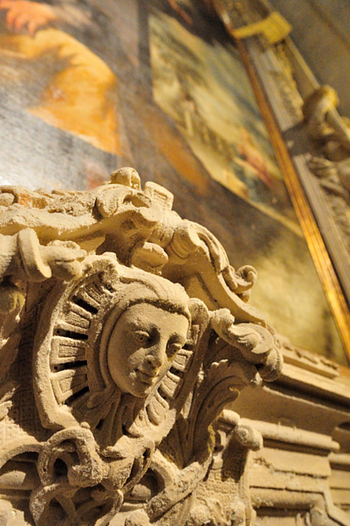 At the start of the 14th century funds were raised to finance further construction, through the imposition of various taxes levied by the Bishop. In the following years, when the Bishop was Lope de Ribas, work on the temple continued apace, and the domes were installed on the cathedral during the 1460s.
At the start of the 14th century funds were raised to finance further construction, through the imposition of various taxes levied by the Bishop. In the following years, when the Bishop was Lope de Ribas, work on the temple continued apace, and the domes were installed on the cathedral during the 1460s.
The churchwarden at this date is known to be Diego Rodríguez de Almela, who was in charge of the numerous master masons who took part in the building work.
Among these latter the most noteworthy was Diego Sánchez, who was involved in the construction of the Cathedral and other civic works such as the Contraparada (a dam and reservoir) for many years.
He is responsible, among other things, for features which dominate today, such as the profile of the building, the Gate of the Apostles, the Chapel of La Visitación (1479), the capitals of the richly decorated columns and the vaulted ceilings.
The temple was consecrated on 20th October, 1467.
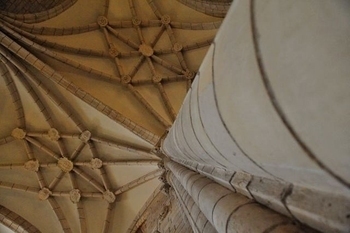 During the tenure of Bishop Rodrigo de Borja (1493-95) the first work on the chapel of Los Vélez was begun, under the auspices of the politician Juan Chacón. This chapel replaced the existing chapel of his father-in-law, Pedro Fajardo.
During the tenure of Bishop Rodrigo de Borja (1493-95) the first work on the chapel of Los Vélez was begun, under the auspices of the politician Juan Chacón. This chapel replaced the existing chapel of his father-in-law, Pedro Fajardo.
The chapel of Los Vélez was finished in 1507.
In the early part of the same century work began on the construction of the new tower, under the directions of the master craftsmen Francisco Florentino, although it actually took nearly 200 years to be completed.
He was succeeded in 1522 by Jacobo Florentino, who was responsible for the interior decorations of the vestry, in the lower part of the tower. Florentino was in turn succeeded in 1526 by Jerónimo Quijano, who oversaw the completion of the first and second parts of the tower.
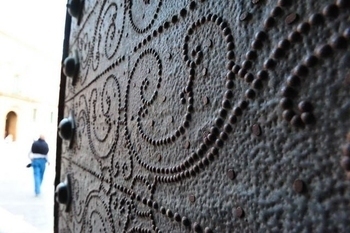 Jerónimo Quijano was in charge of building work until 1563, and work on the tower was unbroken during this period. It was not until the 17th century, when part of it fell down, that work was stopped. Following this setback a start was made on the third level of the tower and the higher levels, under the supervision of José López. In 1785 the tower was finally completed, with the placement of the dome, which was made by Ventura Rodríguez.
Jerónimo Quijano was in charge of building work until 1563, and work on the tower was unbroken during this period. It was not until the 17th century, when part of it fell down, that work was stopped. Following this setback a start was made on the third level of the tower and the higher levels, under the supervision of José López. In 1785 the tower was finally completed, with the placement of the dome, which was made by Ventura Rodríguez.
From its consecration until the completion of the tower, the Cathedral of Santa María de Murcia was increased and enriched by the building in its interior, or as annexes, of a large number of chapels, which brought with them the different artistic trends from the rest of Spain and Europe.
Apart from the chapel of Los Vélez, its worth mentioning the chapels of the Junterones (approximately 1541), built in the style of the Renaissance, which is one of the most beautiful of its type in Spain. Also noteworthy is the chapel of Trascoro (1620), which contains a large altarpiece, and above which is the Merklin organ. In addition, the chapel of Santo Cristo del Milagro contains a neo-classical altarpiece, and many others feature various works of considerable artistic value.
Capilla de los Vélez
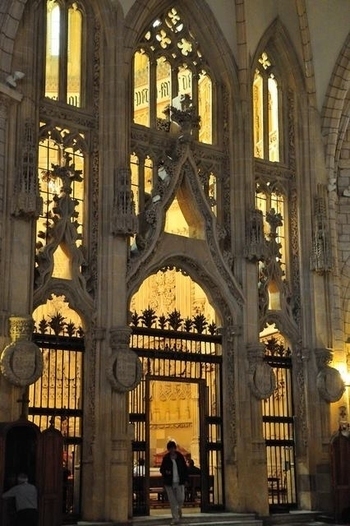 The chapel of Los Vélez stands out for its exuberance and flamboyance, almost a separate building with its own unique personality, the decoration including Romanic, Gothic and Mudéjar elements as well as snippets of Renaissance architecture and art. All of this is perfectly harmonized in anticipation of what would later be termed Plateresque style.
The chapel of Los Vélez stands out for its exuberance and flamboyance, almost a separate building with its own unique personality, the decoration including Romanic, Gothic and Mudéjar elements as well as snippets of Renaissance architecture and art. All of this is perfectly harmonized in anticipation of what would later be termed Plateresque style.
The chapel was declared a National Monument in 1928, and is now also an item of Official Cultural Interest. It was completed in 1509, but unfortunately the name of the architect is not known.
Work was begun in 1490 by Juan Chacón, the military governor of the Kingdom of Murcia, and the chapel was initially dedicated to San Lucas. There are some similarities with the Capilla del Condestable in Burgos and the chapel of Don Alvaro de Luna in Toledo, and as a result of this it was at one time attributed to Juan Guás. This idea has now been completely abandoned.
It is situated on top of the remains of an old Gothic chapel which had been the property of Juan Chacóns father-in-law until it was destroyed to make way for the new chapel. Work was completed by his son, the offspring of his marriage to Luisa Fajardo. This son was Pedro Fajardo, one of the leading figures in the introduction of the Renaissance and Humanism to the south-east of the peninsula.
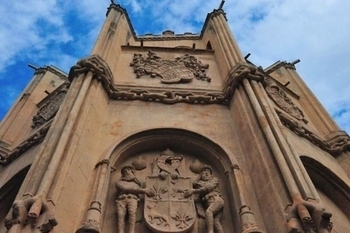 In the chapel there are many sculptural symbols representing clearly the lineage and power acquired by the Fajardo family. One of the most striking examples of this is the stone chain sculptured around the whole of the outside of the chapel, a powerful symbol of power and authority, as well as the reliefs and sculptural elements inside it.
In the chapel there are many sculptural symbols representing clearly the lineage and power acquired by the Fajardo family. One of the most striking examples of this is the stone chain sculptured around the whole of the outside of the chapel, a powerful symbol of power and authority, as well as the reliefs and sculptural elements inside it.
This style of external chain is also used in other contemporary works, such as the Casa de los Momos in Zamora, the Hospital Real in Santiago de Compostela and the Colegio de San Gregorio in Valladolid.
The importance and power of the Fajardos in Murcia is clearly seen in the fact that during its construction it became bigger than originally planned, extending beyond the limits of the cathedral and onto public land. This was imitated later by other individuals who were keen to make a public show of their being as important of the Fajardos, such as Archdeacon Junterones, who made it clear that his chapel was to exceed the boundaries of the cathedral and match the chapel of Los Vélez in its splendor.
The name of the Fajardos crops up again and again throughout Murcian history, and you´ll find many references to them throughout the site.
This magnificent chapel is one of their most enduring monuments and is one of the highlights of a visit to the Cathedral.
The Cathedral Museum
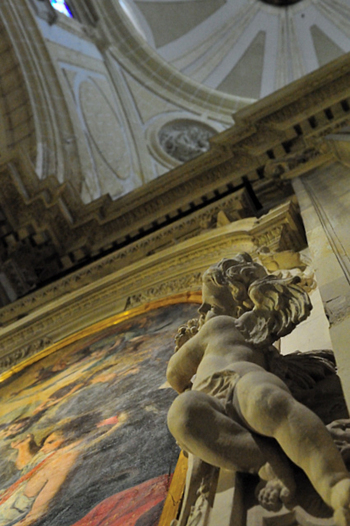 This is located on what was formerly the Muslim Mosque and contains important items relating to the history of the Cathedral.
This is located on what was formerly the Muslim Mosque and contains important items relating to the history of the Cathedral.
Visitors can choose from a wide variety of options, including a visit to the belltower, and groups can also book packages including guided tours of the cathedral.
Murcia Cathedral Museum Opening times:
Winter September to June
Tuesday to September 10-1 and 5-8
Sunday 10-1
Summer ( July and August)
Tuesday to Saturday 10-1pm and 6-8pm
Sunday 10-1pm
Contact the Tourist office on 968 358 749 for details of packages available and costs
Parking for Murcia Cathedral
The nearest parking is the Glorieta underground carpark, which is literally a minutes walk from the Cathedral, which has disabled lifts, so is suitable for those with mobility issues.
It is most easily accessed from the Murcia ringroad, simply drive straight off the ringroad following signs for centro ciudad, down alongside the botanical gardens of Malecon. Stay in the right hand lane. Just past the bridge, drive straight own into the carpark.
It´s literally 2 minutes from the ringroad and couldn´t be easier.
Click for more information about visiting Murcia City











